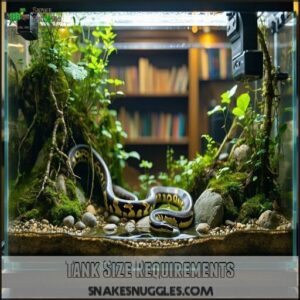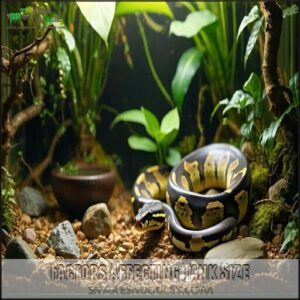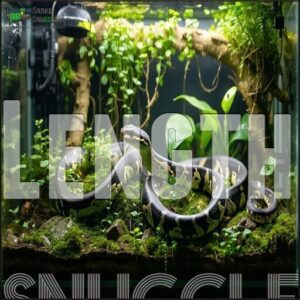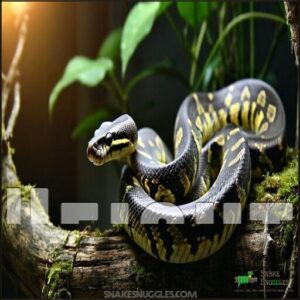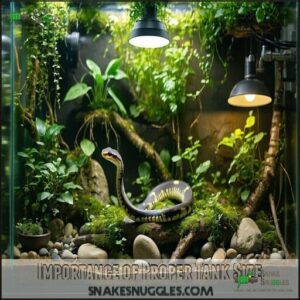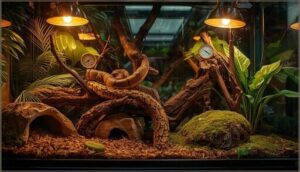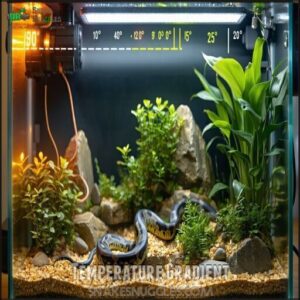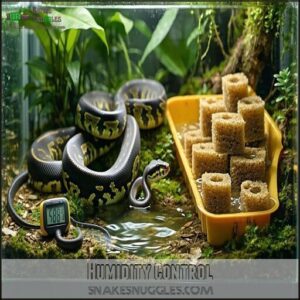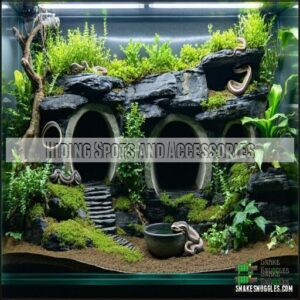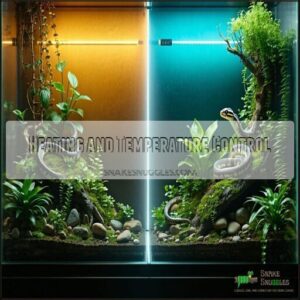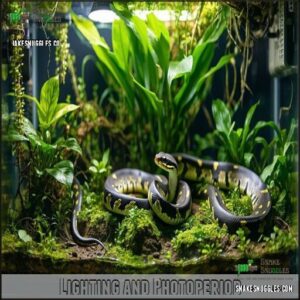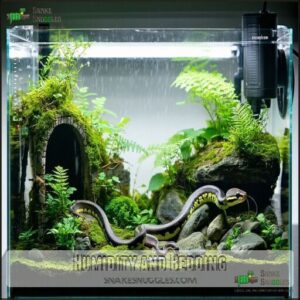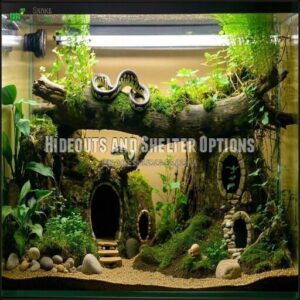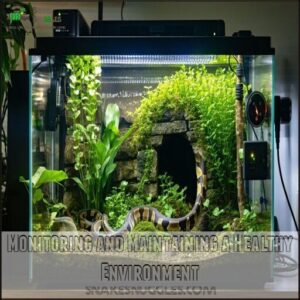This site is supported by our readers. We may earn a commission, at no cost to you, if you purchase through links.
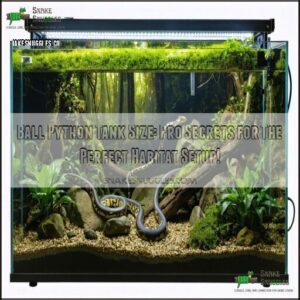
For juveniles, start with a 10-20 gallon enclosure.
Adult ball pythons need a 40-50 gallon tank that’s at least 36 inches long.
Your snake needs room to stretch, explore, and feel secure.
Don’t skimp on space – cramped quarters stress out these reptiles and can lead to health issues.
Verify the tank provides a proper temperature gradient, with warm and cool zones, and includes multiple hiding spots.
The right tank size isn’t just about measurements; it’s about creating a comfortable habitat that mimics their natural environment.
Want to know the secret to a happy, healthy ball python?
Table Of Contents
- Key Takeaways
- Tank Size Requirements
- Factors Affecting Tank Size
- Minimum Dimensions for Ball Python Enclosures
- Importance of Proper Tank Size
- Setting Up The Ideal Ball Python Habitat
- Heating and Temperature Control
- Lighting and Photoperiod
- Humidity and Bedding
- Hideouts and Shelter Options
- Monitoring and Maintaining a Healthy Environment
- Frequently Asked Questions (FAQs)
- What size tank is required for a ball python?
- What size Python tank do I Need?
- How big is a 40 gallon ball python tank?
- Is a 75 gallon tank too small for a ball python?
- How do I choose a ball python tank?
- How much does a ball python tank cost?
- How much water does a ball python need?
- How big should a ball python tank be?
- Is a 75 gallon tank big enough for a ball python?
- Is 120 gallon tank too big for ball python?
- Conclusion
Key Takeaways
- You’ll need to match your ball python’s tank size to its life stage: start with a 10-20 gallon enclosure for juveniles and upgrade to a 40-50 gallon tank for adults, ensuring enough space for stretching and exploring.
- Creating the perfect habitat isn’t just about size—you’ve got to establish a proper temperature gradient with warm and cool zones, multiple hiding spots, and substrate that mimics their natural environment.
- Your ball python’s tank size directly impacts its health, so you’ll want to monitor and maintain consistent temperature (75-80°F) and humidity levels (50-60%), which help prevent stress and support natural behaviors.
- Strategic hide placement is crucial: you’ll want to position at least two shelters—one on the warm side and one on the cool side—to give your snake security and temperature regulation options throughout its enclosure.
Tank Size Requirements
If you’re serious about ball python care, you’ll want to get their tank size just right.
Your snake’s habitat size directly impacts its health, comfort, and overall well-being, so choosing the correct enclosure isn’t just important—it’s essential.
Minimum Tank Size for Ball Pythons
When setting up your ball python’s home, you’ll want to nail the minimum tank size for a happy, healthy snake.
Your reptilian friend needs space to thrive, and choosing the right enclosure is vital. Here’s why tank size matters:
- Supports natural snake behaviors
- Prevents stress-related health issues
- Accommodates growth stages
- Creates a comfortable living environment
Start with a 40-gallon tank to give your ball python the royal treatment. This will help ensure your snake has enough space to thrive.
Optimal Tank Size for Adult Ball Pythons
Size evolution demands strategic planning for your adult ball python’s ideal tank dimensions.
The golden rule? Aim for 75-120 gallon enclosures that transform your snake’s living space into a thriving sanctuary.
Spacious environments reduce stress and promote natural behaviors, ensuring your python’s long-term health and happiness.
Proper tank size considerations involve understanding tank size requirements to create an ideal habitat.
The table outlines key aspects of a ball python’s tank, including tank size, space needs, and habitat quality, all of which impact the snake’s well-being and long-term health.
Tank Size Recommendations for Juvenile Ball Pythons
When nurturing a juvenile ball python, your choice of tank matters.
A 20 to 30-gallon habitat becomes their perfect growth sanctuary.
Here’s why:
- Precise space supports healthy development
- Comfortable dimensions encourage natural behaviors
- Strategic sizing prevents overwhelming environments
Your young snake deserves a snug, customized home that adapts with its growing needs, ensuring stress-free maturation and ideal health.
Factors Affecting Tank Size
When setting up your ball python’s home, you’ll need to take into account several key factors that influence tank size.
Your snake’s length, activity level, growth rate, and enrichment needs will determine the perfect enclosure dimensions for a happy, healthy reptile.
This will ensure that all aspects of the snake’s environment are considered to create an ideal space.
Snake Length and Girth
Your ball python’s length is the compass guiding your tank size journey. Female pythons can stretch up to 6 feet, while males typically max out around 3.5 feet.
Think of snake measurement as your roadmap for creating the perfect habitat.
| Snake Length (inches) | Minimum Tank Length (inches) | Minimum Tank Width (inches) |
|---|
Pro tip: Regularly check your snake’s body proportions. Girth ratio matters just as much as total length when scaling tank guidelines. A well-fitted tank guarantees your slithery friend has room to stretch, curl, and feel secure.
Understanding proper tank size guidelines is vital for a healthy environment, and you can find more information at tank size guidelines.
Your python’s length isn’t just a number—it’s the key to a happy, healthy home, where your snake can thrive with the right tank size and environmental conditions.
Activity Level
After measuring your snake’s length, understanding its activity level becomes your next habitat-planning checkpoint.
Your ball python’s movement patterns reveal vital insights about ideal enclosure dimensions.
Consider these behavioral cues:
- Frequent exploratory slithering suggests more spacious tank sizing
- Minimal wandering indicates comfort with compact environments
- Consistent hide-and-seek behaviors signal specific spatial preferences
Matching tank dimensions to your snake’s unique activity cycles guarantees a perfectly customized, stress-free home, ensuring your snake’s comfort and well-being is maintained through a well-designed enclosure.
Enrichment Needs
Your ball python craves more than just square footage.
Smart enrichment transforms a basic enclosure into a sensory playground that triggers natural behaviors.
By introducing varied substrate options, strategic hiding spots, and exploration activities, you’ll create a habitat complexity that stimulates your snake’s mental and physical well-being.
Environmental variety is key to a thriving companion, and this complexity is essential for your snake’s overall health, making natural behaviors a crucial aspect of their care.
Growth Rate
When your ball python hits its growth stride, you’ll want to stay ahead of its habitat needs.
These snakes typically grow 2-3 inches monthly in their first year, with males reaching 3-3.5 feet and females stretching 4-6 feet.
Monitoring weight gain—around 50-100 grams monthly for juveniles—helps you predict tank size upgrades.
Watch for shedding patterns and weight changes as key indicators.
By tracking your snake’s development, you’ll guarantee a comfortable, stress-free environment that supports healthy growth and prevents cramped living conditions.
Minimum Dimensions for Ball Python Enclosures
When setting up your ball python’s home, you’ll want to get the tank dimensions just right to keep your scaly friend happy and healthy.
The key is matching the enclosure’s length, width, and height to your snake’s size, ensuring enough space for stretching, exploring, and feeling secure, which is crucial for keeping your snake healthy.
Length
Ready to give your ball python the space it craves? The secret’s in matching tank length to your snake’s full body size.
Follow this golden rule:
- Match Length: Enclosure equals snake’s total length.
- Growth Tracking: Adjust tank as your python grows.
- Comfort Zone: Prevent stress with proper space.
Snug doesn’t mean tiny—give your slithery friend room to stretch!
Ensuring the right enclosure size matters for a healthy ball python.
Width
Your snake’s kingdom demands room to roam! When planning tank width for ball python tank size, aim for at least 24 inches—giving your scaled companion space to stretch without feeling squeezed.
A narrow enclosure cramps their style and can trigger stress. Think of width as your python’s personal highway: wider means happier, more comfortable living quarters, where your python can live without feeling squeezed.
Height
Elevate your ball python’s habitat by strategically planning tank height.
Your enclosure should provide 18-24 inches of vertical space, offering just enough room for occasional climbing without overwhelming your scaly friend.
This sweet spot supports natural behaviors while preventing potential falls, ensuring your python stays safe and enriched in its perfectly designed home.
Importance of Proper Tank Size
Getting the right tank size for your ball python isn’t just about space—it’s about creating a habitat that supports their health and happiness.
Create a ball python sanctuary that’s more than just a tank—it’s a thriving, life-supporting habitat of comfort and care.
Your snake’s well-being depends on an enclosure that allows natural behaviors, prevents stress, and promotes long-term thriving.
Health Implications of Inadequate Tank Size
Because cramped spaces spell disaster for ball pythons, understanding minimum tank size requirements is essential.
Insufficient space triggers serious health risks like muscle atrophy, respiratory issues, and chronic stress. Tank trauma can lead to skeletal deformities, impaired movement, and compromised immune function.
Your snake’s well-being depends on providing an environment that allows natural behaviors and supports healthy physical development, preventing issues like muscle atrophy.
Impact on Ball Python Behavior
Your ball python’s behavior hinges on more than just feeding and handling—its tank size plays a pivotal role. A well-designed enclosure transforms your pet’s world, allowing natural exploration and reducing stress levels.
When you provide ample space, you’re not just setting up a habitat; you’re creating an environment that supports your python’s physical and psychological well-being.
- Encourages instinctive movement patterns
- Minimizes potential behavioral disruptions
- Promotes mental stimulation and comfort
Understanding space requirements isn’t just scientific—it’s about giving your scaly companion room to thrive. This understanding is crucial for creating a harmonious and healthy environment for your pet, where it can engage in natural exploration.
Relationship Between Tank Size and Lifespan
Your ball python’s lifespan hinges on tank size, much like a gardener nurturing a delicate plant.
Tank size is the foundation of your ball python’s health, nurturing its potential like a gardener tends a precious seedling.
Proper enclosure dimensions support natural behaviors, reducing stress and promoting healthier growth.
Expansive habitats allow for exploration, muscle development, and psychological well-being.
| Tank Size | Health Impact | Lifespan Potential |
|---|---|---|
| Small | High Stress | Limited Growth |
| Moderate | Balanced | Normal Development |
| Large | Low Stress | Peak Longevity |
| Spacious | Enriched | Maximum Potential |
| Ideal | Comfortable | Extended Life |
The table illustrates the impact of different tank sizes on the health and lifespan potential of ball pythons, highlighting the importance of providing a suitable environment for their well-being and maximum potential.
Setting Up The Ideal Ball Python Habitat
Creating the perfect ball python habitat isn’t just about size—it’s about mimicking their natural environment with precision and care.
You’ll want to focus on key elements like temperature gradients, humidity control, substrate selection, and strategic hiding spots to guarantee your snake feels secure and thrives in its new home.
Substrate Options
When selecting substrate for your ball python’s tank, prioritize comfort and functionality.
Your reptile’s home deserves careful attention to bedding materials that support natural behaviors:
- Cypress Mulch: Moisture-retaining champion
- Aspen Bedding: Dust-free comfort zone
- Paper-based Substrates: Clean and absorbent
- DIY Mixes: Customizable humidity control
Choosing the right substrate is essential for creating a healthy environment, and understanding Ball Python Substrate options is vital for your pet’s well-being.
Choose wisely to create a cozy, health-supporting environment that mimics your python’s natural habitat while making maintenance a breeze.
Temperature Gradient
Your substrate’s set—now let’s dial in your snake’s perfect temperature paradise.
Creating an ideal thermal gradient isn’t rocket science, but it does require precision.
Your ball python needs zones that mimic its natural habitat, ranging from warm retreats to cooler lounging spots.
| Heat Zone | Temperature | Purpose |
|---|---|---|
| Basking | 90-93°F | Warmth & Digestion |
| Ambient | 80-85°F | Normal Activity |
| Cool Side | 75-80°F | Temperature Regulation |
Heat mats work wonders for establishing these temperature zones.
Pro tip: Always place heating elements on one side, never directly underneath your snake.
Use a reliable digital thermometer to monitor both warm and cool areas.
This gradient lets your python play temperature conductor, moving between zones to maintain its perfect internal climate.
Smart heating means a happy, healthy snake, ensuring a happy and healthy environment.
Humidity Control
After perfecting your python’s temperature gradient, mastering humidity levels becomes your next mission.
Grab a hygrometer and track moisture between 50-60% normally, ramping up to 70-80% during shedding.
Strategic water bowls, occasional misting, and moisture-retaining substrates like cypress mulch create the ideal hydration haven for your scaly friend’s thermoregulation and comfort.
Hiding Spots and Accessories
After mastering humidity, let’s make your ball python’s home a stress-free sanctuary.
Snake hides aren’t just decorations—they’re survival gear. Place rock caves and plant decor in warm and cool zones to mimic natural habitats.
Your snake needs multiple hiding spots to feel secure. Budget-friendly DIY rock caves and strategic water bowl placement can transform your ball python’s enclosure into a five-star retreat.
Heating and Temperature Control
You’ll want to nail your ball python’s heating setup to keep your slithery friend healthy and happy.
Getting the temperature gradient just right isn’t rocket science – with the right equipment and know-how, you’ll create a cozy habitat that mimics your snake’s natural environment.
Heating Equipment Options
Want to warm up your ball python’s world? Heat mats and heat lamps are your go-to heating equipment.
Slip a heat mat under the tank for gentle, belly-warming comfort. Pair heat lamps with ceramic emitters to create perfect temperature zones.
Always use a reliable thermostat to prevent overheating and keep your scaly friend safe and toasty. For ideal heat distribution, consider using heat mat products to maintain a stable temperature.
Temperature Requirements for Ball Pythons
Your ball python’s comfort depends on precise temperature management.
Maintain a daytime range of 75-80°F, with nighttime temperatures dropping to 70-75°F.
Strategic heat sources like mats and lamps create ideal thermal cycles.
Consistent monitoring guarantees your snake thrives, mimicking its natural habitat’s temperature gradients and supporting peak health and activity levels.
Maintaining Proper Heat Gradient
Your ball python needs three strategic heat sources to thrive: heat mats, lamps, and thermostats. Creating an ideal thermal gradient isn’t rocket science—it’s about precision and care.
Follow these four critical steps:
- Position heat mats strategically
- Select appropriate heat lamp wattage
- Install accurate temperature probes
- Monitor basking spot temperatures consistently
To achieve the perfect habitat, understanding the importance of a temperature gradient is vital for your ball python’s health and well-being.
Lighting and Photoperiod
You’ll want to understand how lighting impacts your ball python’s health and behavior in captivity.
By setting up the right photoperiod, you’ll mimic their natural habitat and support their circadian rhythm, ensuring your snake stays happy and thriving.
Importance of Light in Ball Python Tanks
Let’s dial in the light dynamics for your scaly friend’s habitat.
Proper lighting isn’t just about brightness—it’s about creating a natural rhythm that keeps your ball python healthy and calm.
UVB lighting offers vision benefits, helping your snake perceive its environment more clearly.
By mimicking natural light cycles, you’ll reduce stress and support your python’s biological clock.
Think of lighting as a subtle conductor orchestrating your snake’s daily performance, influencing behavior, mood, and overall well-being in its carefully curated tank space.
Suitable Lighting Options for Ball Pythons
Illuminating your ball python’s habitat doesn’t require complex lighting setups. Your snake thrives in low-light conditions, making UVB lighting unnecessary.
Consider these key lighting principles:
- Use ambient light for natural illumination
- Opt for soft LED options
- Avoid direct, intense light sources
Subtle lighting helps showcase your snake’s stunning scales while maintaining their natural comfort.
LED strips or low-wattage bulbs can create a gentle glow, ensuring your python feels secure without disrupting their temperature gradient or daily rhythms.
Setting Up a Proper Photoperiod
The rhythm of light plays a vital role in regulating your ball python’s circadian rhythm. Your goal? Creating a stable photoperiod that mimics natural day-night cycles.
Here’s how to nail the perfect light cycle:
- Install a digital timer for consistent lighting
- Maintain 12-hour light/dark intervals
- Use full-spectrum UVB lighting for visibility
- Adjust seasonal variations with careful monitoring to achieve the perfect light cycle.
Humidity and Bedding
Getting the humidity right and choosing the perfect bedding can make or break your ball python’s health and happiness.
Your snake’s comfort depends on creating a carefully balanced environment that mimics its natural habitat, so let’s explore the secrets to nailing the ideal humidity levels and substrate for your scaly friend, focusing on the natural habitat.
Ideal Humidity Levels for Ball Pythons
In the delicate dance of humidity control, your ball python’s tank size matters as much as moisture levels.
Aim for a steady 50-60% humidity, ramping up to 70-80% during shedding periods.
A reliable hygrometer becomes your secret weapon for tracking these critical conditions.
Cypress mulch serves as an excellent substrate, helping retain that perfect moisture balance.
Water bowls and occasional misting can nudge humidity in the right direction.
Remember, consistent humidity isn’t just a numbers game—it’s about creating a comfortable, stress-free environment for your scaly friend, where a reliable hygrometer and proper substrate like cypress mulch play key roles.
Methods to Increase or Decrease Humidity
Like a thermostat for your slithery friend, humidity control keeps ball pythons comfortable.
Mist the enclosure strategically, using water bowls and foggers to dial in those perfect humidity levels.
Want to boost moisture? Try spray systems or add a humid hideout.
Feeling overwhelmed? Cypress mulch can help regulate dampness.
Too wet? Increase ventilation.
Your snake’s environment is a delicate balance—aim for that sweet spot between 40-60% humidity, where precision is your secret weapon in snake care.
Safe and Recommended Substrate Choices
When creating a ball python habitat, substrate choices can make or break your snake’s comfort zone. Your goal? Pick the perfect bedding that balances moisture control and cleanliness.
- Cypress mulch offers excellent humidity retention
- Paper-based substrates provide clean, dust-free coverage
- Avoid toxic woods like cedar and pine
Each substrate option brings unique benefits. From moisture management to ease of cleaning, understanding these choices helps you craft a safe, healthy environment that’ll make your ball python feel right at home.
Hideouts and Shelter Options
You’ll want to create a safe haven for your ball python with strategic hideouts that mimic their natural habitat and provide essential comfort.
By understanding how to choose and place the right shelters, you’ll help your snake feel secure, reduce stress, and encourage natural behaviors in its tank environment.
Types of Hides for Ball Pythons
After carefully managing humidity levels, you’ll want to focus on creating safe, comfortable hideouts for your ball python. Your snake craves security, just like a hermit crab seeking its perfect shell.
Different hide types offer unique benefits:
| Hide Type | Emotional Response | Comfort Level |
|---|---|---|
| Rock Hides | Primitive Safety | High |
| Log Hides | Natural Refuge | Medium-High |
| Cave Hides | Protective Sanctuary | Very High |
These strategic shelters transform your ball python’s habitat into a stress-free haven. Providing the right ball python hides and shelters is vital for their well-being.
Placing Hides in The Tank
Master your ball python’s hide placement with a strategic two-hide approach.
Position one hide on the warm side and another on the cool side of the tank, creating essential temperature options.
These hideouts serve as visual barriers and comfort zones, encouraging natural behavior while supporting your snake’s need for security in their carefully designed habitat.
Creating a Secure and Comfortable Shelter Environment
When setting up hideouts, think beyond basics to craft a sanctuary that speaks to your ball python’s instincts.
Choose sturdy rock caves and PVC pipes wide enough for comfortable coiling. Position shelters strategically to offer security and easy movement.
The right shelter design transforms your python’s tank into a stress-free haven that mimics their natural habitat, promoting healthy, relaxed behavior, and creates a space that is a true sanctuary.
Monitoring and Maintaining a Healthy Environment
You’re the guardian of your ball python’s health, and monitoring its environment is vital for its well-being.
Regularly checking temperature, humidity, and your snake’s behavior will help you catch potential issues early and guarantee a thriving, stress-free habitat.
This process allows you to ensure your snake’s well-being by maintaining optimal conditions.
Checking Temperature and Humidity Levels
Two critical metrics define your ball python’s habitat health: temperature and humidity. Getting these right is like creating a five-star reptile resort.
Consider these key monitoring strategies:
- Use digital thermometers with probe placements
- Calibrate hygrometers regularly for accuracy
- Establish multiple temperature gradient zones
- Track humidity levels with reliable devices
- Create consistent thermal environments
Your goal? Maintain a basking surface around 90-92°F (32-33°C) and monitor humidity scrupulously. A well-regulated environment prevents stress and supports your snake’s overall well-being, transforming their enclosure from mere shelter to a perfect habitat.
Monitoring Ball Python Behavior and Activity
Your ball python’s behavior is like a secret language waiting to be decoded. By tuning into their activity patterns, you’ll become a pro at understanding their health and happiness.
Check out this quick reference guide to snake activity:
| Behavior | Good Sign | Warning Sign |
|---|---|---|
| Movement | Exploring | Constant hiding |
| Appetite | Regular eating | Repeated food refusal |
| Shedding | Clean, complete shed | Incomplete or irregular shed |
| Energy | Active periods | Persistent lethargy |
| Interaction | Calm handling | Excessive defensive posture |
Keep your eyes peeled and your instincts sharp, and remember to look for complete concepts and good signs to ensure your ball python is thriving.
Recognizing Signs of Stress or Illness
You’re the detective in your python’s health mystery.
Watch for telltale stress signals like sudden appetite changes, unusual lethargy, or irregular shedding.
Behavioral changes can reveal hidden health issues lurking beneath the surface.
Consistent observation is your best tool—when something feels off, trust your instincts.
A quick environment check or veterinary consultation can prevent potential snake welfare complications, and this is a matter of snake welfare, so it’s crucial to be aware of hidden health issues.
Frequently Asked Questions (FAQs)
What size tank is required for a ball python?
When you’re ready to bring a slithery friend home, size matters.
Your ball python needs a 40-gallon tank as a starting point, with adults thriving best in 75-120 gallon enclosures that provide ample space to stretch and explore.
This provides a clear and comfortable environment for your pet.
What size Python tank do I Need?
You’ll need a 20-gallon tank for a baby python, upgrading to 75-120 gallons as an adult.
Make certain the enclosure matches your snake’s length, provides temperature gradients, and offers cozy hiding spots for comfort and security, which includes ensuring the setup is suitable for the snake’s overall well-being and security.
How big is a 40 gallon ball python tank?
Like a cozy bedroom for your slithery friend, a 40-gallon tank typically measures around 36"L x 18"W x 16"H.
It’ll give your ball python plenty of space to stretch, hide, and feel secure in its new home.
Is a 75 gallon tank too small for a ball python?
A 75-gallon tank isn’t too small for most adult ball pythons.
You’ll want to prioritize floor space over volume, ensuring your snake can stretch out comfortably and thermoregulate effectively in its habitat.
How do I choose a ball python tank?
When selecting a ball python tank, consider your snake’s size, age, and behavior.
Opt for a secure, spacious enclosure with proper temperature gradients, hiding spots, and appropriate substrate to guarantee your reptile’s comfort and well-being, ensuring a suitable environment for your reptile.
How much does a ball python tank cost?
Wondering about ball python tank costs?
Brace yourself for a range between $50 and $300, depending on size, material, and features.
Your wallet’s adventure begins with basic terrariums and climbs with custom enclosures.
How much water does a ball python need?
You’ll want to provide a shallow water dish large enough for your ball python to soak and drink.
Change it daily, keeping the water clean and fresh to prevent bacterial growth and guarantee proper hydration.
How big should a ball python tank be?
You’ll need a 20-30 gallon tank for young ball pythons and 75-120 gallons for adults.
Prioritize floor space over height, ensuring your snake can stretch comfortably and feel secure in its habitat.
Is a 75 gallon tank big enough for a ball python?
A 75-gallon tank offers ample space for your adult ball python, providing room to stretch, explore, and feel secure.
It meets minimum requirements, ensuring your snake’s comfort and well-being with proper temperature gradients and hiding spots, which are crucial for the snake’s overall well-being.
Is 120 gallon tank too big for ball python?
Forsooth, a 120-gallon tank isn’t too big—it’s a snake’s paradise.
You’ll provide ample floor space, which matters more than volume.
Just guarantee proper temperature gradients and hiding spots for your slithery companion’s comfort and security.
Conclusion
Worried about getting your ball python’s tank size wrong? Don’t sweat it! Mastering ball python tank size requirements isn’t rocket science.
By providing the right space—40-50 gallons for adults, 10-20 for juveniles—you’ll create a thriving habitat. Remember, it’s not just about square footage; it’s about mimicking their natural environment.
Invest in proper dimensions, temperature gradients, and hiding spots. Your scaly friend will thank you with vibrant health and a stress-free life.
- https://www.wilbanksreptiles.com/blogs/ideal-tank-size-for-healthy-ball-pythons/what-is-the-recommended-tank-size-for-a-ball-python?srsltid=AfmBOoph3_qAQhP6oUCqgmy1NtKr1iIvimNR7fxQnVve9EPv2CDoa9mt
- https://www.quora.com/Is-a-55-gallon-tank-too-big-for-a-ball-python
- https://www.reddit.com/r/snakes/comments/3fx9b4/tank_size_for_a_ball_python/
- https://zoomed.com/ball-python/
- https://reptifiles.com/ball-python-care-guide/ball-python-terrarium-size-lighting/

